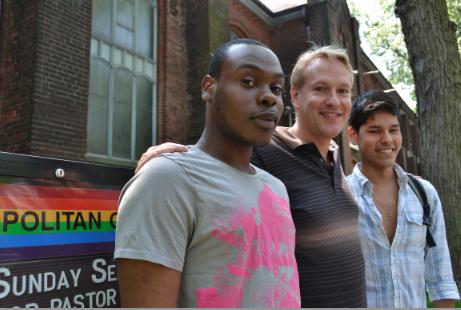Even though Dane Shortt started a gay-straight alliance (GSA) at his west-end high school, he always felt like he had a target on his back. So, when he was forced to leave his school in September, he found safety at the Triangle Program, Canada’s only all-queer classroom.
“If you don’t push [bullies] and show that you’re there, no one’s ever going to take you seriously,” says the confident and charming 19-year-old. “I didn’t mind the bullying at first, but after some guys chased me I realized it was getting serious.”
Teacher Jeffrey White says the Triangle Program is no longer a transitional program for queer kids who have been bullied at school. It has evolved into a full secondary school offering grades 9 to 12, with cutting-edge curriculum and a classroom culture like no other.
But, for White, it’s still just a Band-Aid solution that he hopes will one day not be needed at all.
This year the Triangle Program, part of the Toronto District School Board (TDSB), celebrates its 15th anniversary. The program was the first of its kind in the world, giving gay, lesbian and trans students a refuge from the torment and bullying in mainstream schools.
White, who started 15 years ago as a volunteer, says the program has evolved from a transitional program, to which students escape for a short time, rebuild their self-esteem and move back to mainstream school. “A student can now come any time during high school, stay for the entire time, graduate from here and go on to post-secondary or right into the workplace, so that’s really exciting.”
Xtra spent a recent afternoon in the Triangle Program’s bright and sunny classroom, a donated space in the basement of the Metropolitan Community Church of Toronto, chatting with students before the start of summer holidays. On June 27, many will dress to impress and join hundreds of other queer youth from all over the Greater Toronto Area at the 15th Pride Prom at Buddies in Bad Times Theatre.
When White started teaching at the program in 2001 there were 18 students; now there are 42. Some students commute from the far reaches of the GTA, catching buses, subways and GO trains to get to class. “We normally find we’re full after the first week of school; then we have a waiting list. But if there’s a youth at risk at their school we always take them into the program.”
Many still come from families that are very unsupportive, some even abusive, and about 40 to 50 percent are living on their own because their parents have kicked them out, White says.
“I can tell you that students who come to the program still come with the same stories that I heard when I started high school in 1979. They are getting verbally harassed and they are getting physically harassed. The bullying is still there and it’s starting a lot younger.”
In the Toronto public board, things are definitely getting better, White says. Most schools have anti-homophobia and anti-transphobia information, most schools have GSAs, and “staff and administration are in full support.”
That isn’t the case in Ontario’s Catholic school system, he says.
When students arrive to the program, White says, it sometimes takes six months to a year to rebuild their confidence and make them feel welcome. A big part of the work is undoing the damage done at mainstream schools.
“We show them where LGBTQ people have been in the past and where we are today, the journeys. They get a real sense of who they are and where they come from. A lot of young people that come to the program are really destroyed,” he says.
“They don’t look up off the ground. They don’t engage you because they’ve just been so damaged by homophobia and transphobia. Imagine — beaten up regularly and told you’re not worthy and you’re going to hell.”
Nick Silveri, 20, has been working on Grade 12 courses. When asked what it’s like to be at school with only queer students, he says, it’s “a lot of drama.”
“In a normal high school the question is Who’s the minority gay? Here, the question becomes Who’s the loudest? Who’s the queeniest? Who’s the bitchiest? It’s different competitions.”
But the best part is seeing changes at home. He says he brings the positive message home to change minds, starting with his family. “I’m trying to teach my mom. She grew up with a Catholic mindset in a small town. She is very closed-minded, but she’s learning. It’s such a different world for her. I don’t expect her to accept everything. I think it’s good she’s at least listening.”
“I’ve had such a positive experience at this school, especially academically,” he says. “This school definitely opens your mind up to different issues.”

 Why you can trust Xtra
Why you can trust Xtra


